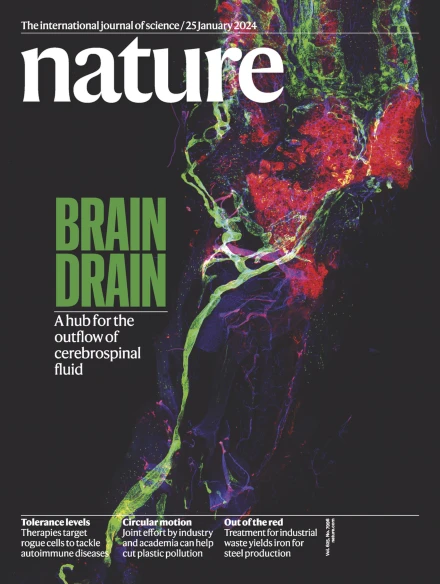APOE4/4 与阿尔茨海默病小胶质细胞中的损伤性脂滴有关。
IF 50.5
1区 综合性期刊
Q1 MULTIDISCIPLINARY SCIENCES
引用次数: 0
摘要
阿尔茨海默病的几个遗传风险因素与脂质代谢基因有关,其中许多脂质基因在神经胶质细胞中高度表达1。然而,人们对神经胶质细胞的脂质代谢与阿尔茨海默病病理之间的关系仍然知之甚少。通过对阿尔茨海默氏症患者脑组织的单核 RNA 测序,我们发现了一种由脂滴相关酶 ACSL1 的表达所定义的小胶质细胞状态,在具有 APOE4/4 基因型的阿尔茨海默氏症患者中,ACSL1 阳性的小胶质细胞最为丰富。在人类诱导多能干细胞衍生的小胶质细胞中,纤维 Aβ 以 APOE 依赖性方式诱导 ACSL1 表达、甘油三酯合成和脂滴积累。此外,来自含脂滴小胶质细胞的条件培养基会以 APOE 依赖性方式导致 Tau 磷酸化和神经毒性。我们的研究结果表明,阿尔茨海默病的遗传风险因素与小胶质细胞脂滴积累和神经毒性小胶质细胞衍生因子之间存在联系,这有可能为阿尔茨海默病提供治疗策略。本文章由计算机程序翻译,如有差异,请以英文原文为准。


APOE4/4 is linked to damaging lipid droplets in Alzheimer’s disease microglia
Several genetic risk factors for Alzheimer’s disease implicate genes involved in lipid metabolism and many of these lipid genes are highly expressed in glial cells1. However, the relationship between lipid metabolism in glia and Alzheimer’s disease pathology remains poorly understood. Through single-nucleus RNA sequencing of brain tissue in Alzheimer’s disease, we have identified a microglial state defined by the expression of the lipid droplet-associated enzyme ACSL1 with ACSL1-positive microglia being most abundant in patients with Alzheimer’s disease having the APOE4/4 genotype. In human induced pluripotent stem cell-derived microglia, fibrillar Aβ induces ACSL1 expression, triglyceride synthesis and lipid droplet accumulation in an APOE-dependent manner. Additionally, conditioned media from lipid droplet-containing microglia lead to Tau phosphorylation and neurotoxicity in an APOE-dependent manner. Our findings suggest a link between genetic risk factors for Alzheimer’s disease with microglial lipid droplet accumulation and neurotoxic microglia-derived factors, potentially providing therapeutic strategies for Alzheimer’s disease. A microglial state, featuring lipid droplets and secretion of neurotoxic factors, is shown to be most prominent in people with Alzheimer’s disease who have the APOE4 genotype.
求助全文
通过发布文献求助,成功后即可免费获取论文全文。
去求助
来源期刊

Nature
综合性期刊-综合性期刊
CiteScore
90.00
自引率
1.20%
发文量
3652
审稿时长
3 months
期刊介绍:
Nature is a prestigious international journal that publishes peer-reviewed research in various scientific and technological fields. The selection of articles is based on criteria such as originality, importance, interdisciplinary relevance, timeliness, accessibility, elegance, and surprising conclusions. In addition to showcasing significant scientific advances, Nature delivers rapid, authoritative, insightful news, and interpretation of current and upcoming trends impacting science, scientists, and the broader public. The journal serves a dual purpose: firstly, to promptly share noteworthy scientific advances and foster discussions among scientists, and secondly, to ensure the swift dissemination of scientific results globally, emphasizing their significance for knowledge, culture, and daily life.
 求助内容:
求助内容: 应助结果提醒方式:
应助结果提醒方式:


